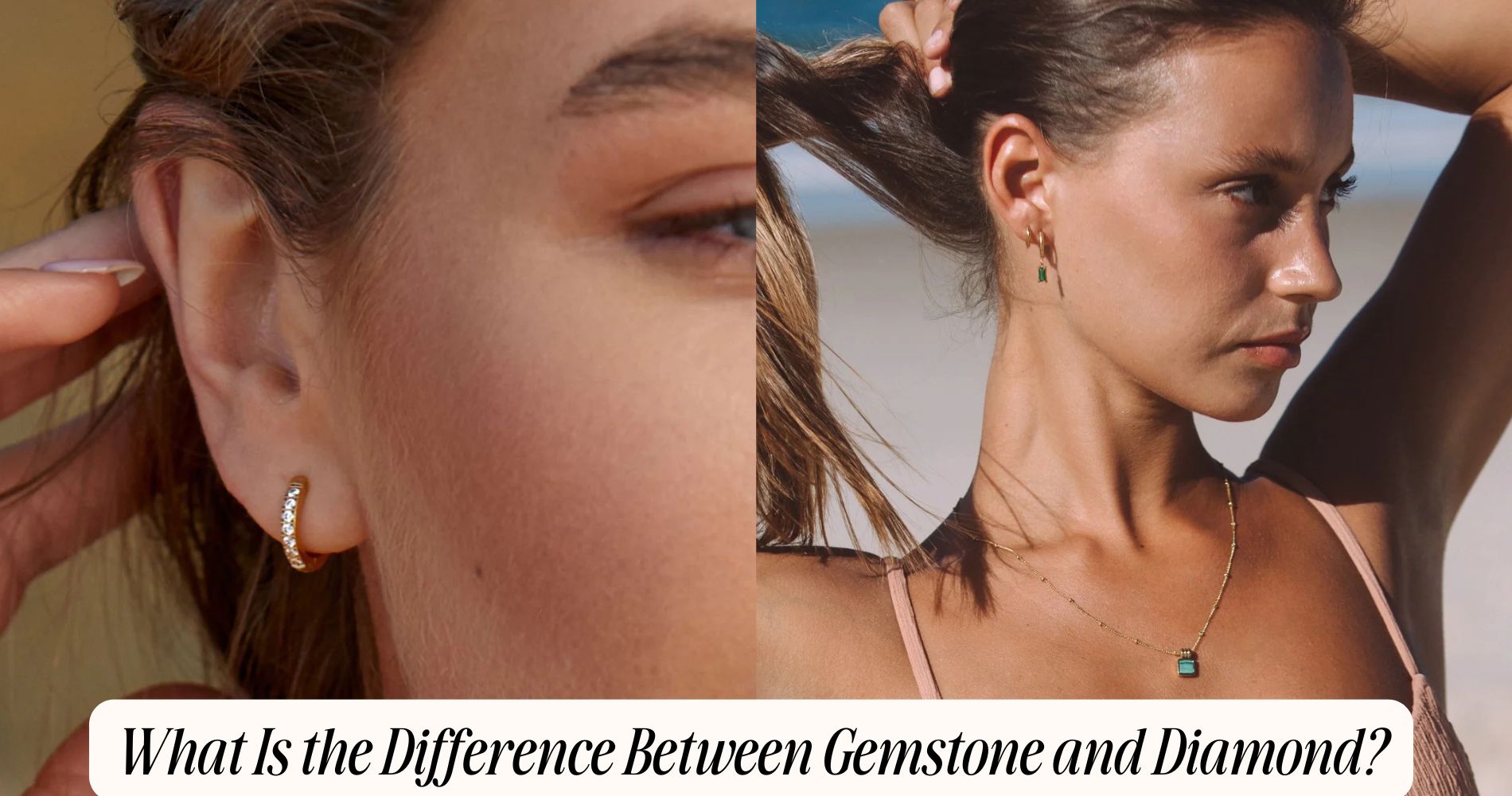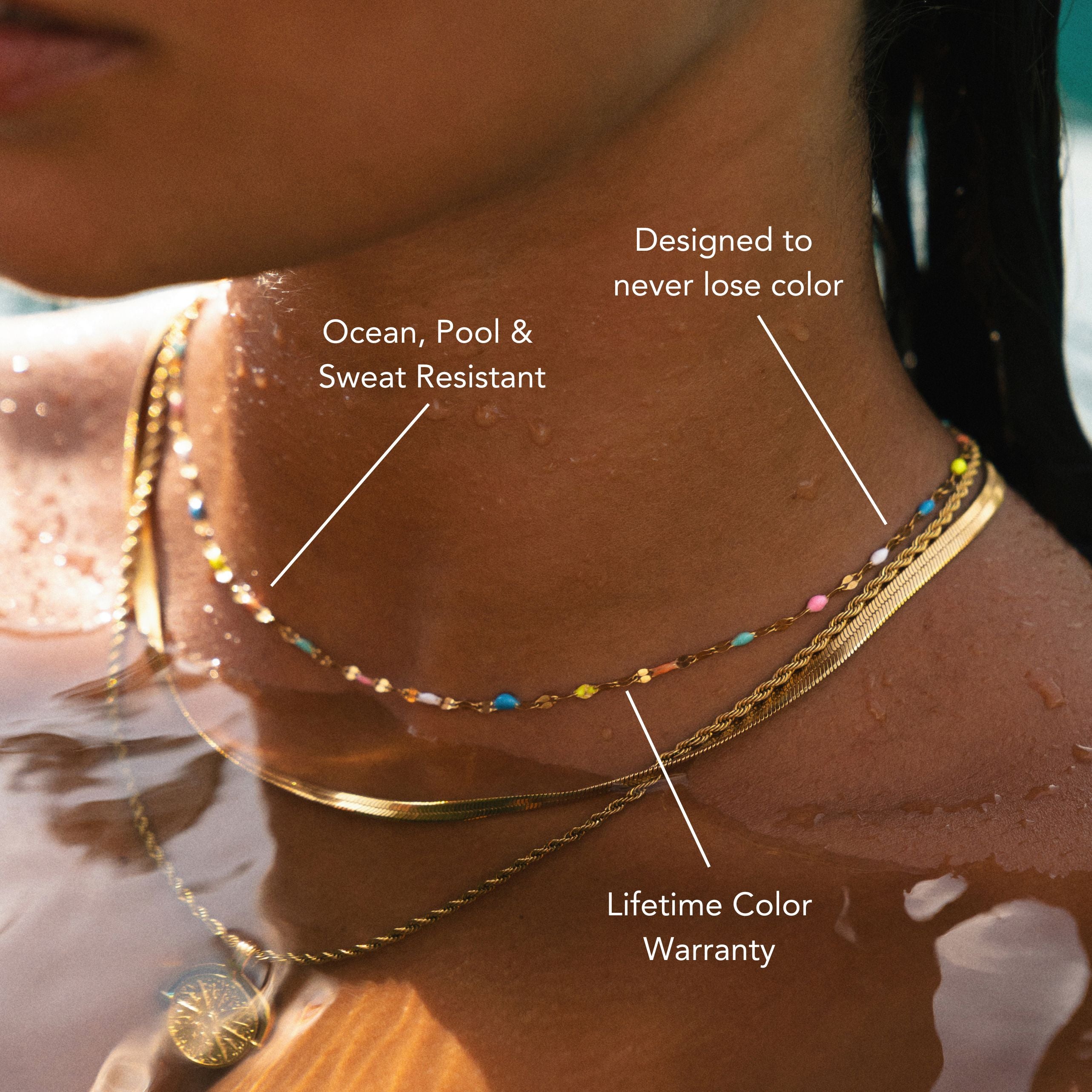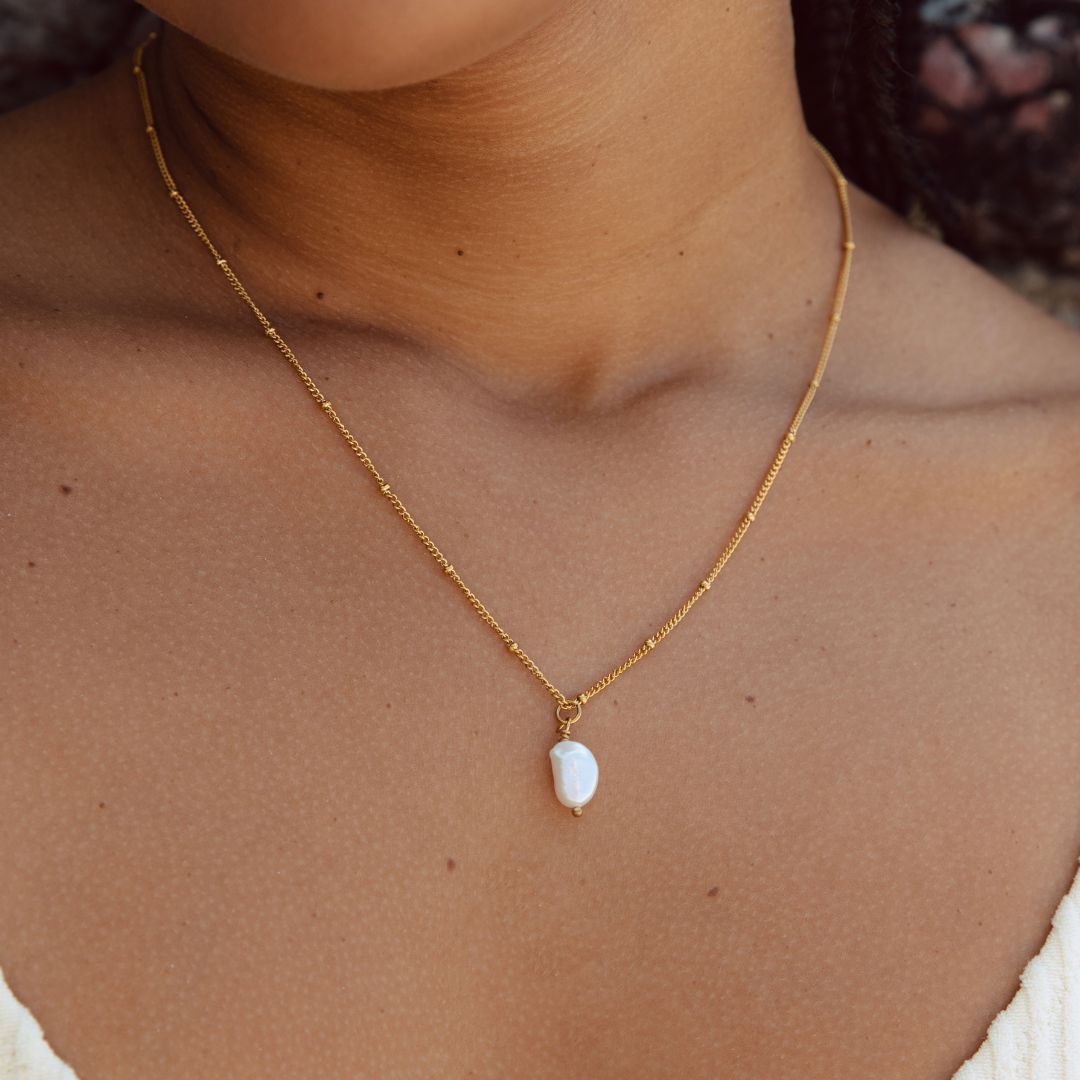
What Is the Difference Between Gemstone and Diamond?
What is the difference between gemstone and diamond? Gemstones encompass a diverse range of naturally occurring minerals and organic materials, while diamonds are a specific type of gemstone renowned for their exceptional properties. Composed entirely of carbon arranged in a crystal lattice, diamonds stand out for their unparalleled hardness and brilliance. In contrast, gemstones include both precious and semi-precious varieties, each with unique characteristics that shape their appeal. The cultural significance of both gemstones and diamonds plays a vital role in their use in jewelry. For enduring, high-quality pieces, explore our anti-tarnish jewelry collection. Understanding these differences is crucial for making informed choices when selecting gems and appreciating their market value and allure.
Definition of Gemstones
A gemstone is a naturally occurring mineral or organic material that's cut, polished, and used primarily for ornamental purposes or as a form of jewelry.
In the world of gemstones, classification plays a vital role. You'll encounter categories such as precious and semi-precious stones, which depend on factors like rarity, durability, and aesthetic appeal. Precious gemstones, including diamonds, rubies, sapphires, and emeralds, often command higher prices due to their perceived value.
Understanding gemstone symbolism is equally important. Different cultures attribute various meanings to gemstones, which can influence your choice in jewelry. For instance, sapphires symbolize wisdom and nobility, while amethysts are associated with clarity and peace. This symbolic significance can enhance the emotional connection you have with your jewelry, making it more than just an aesthetic choice.
When you evaluate gemstones, remember that their intrinsic properties, such as hardness and refractive index, will also affect their classification and desirability. Analyzing these factors can aid in making informed decisions whether you're purchasing a piece for yourself or as a gift.
Definition of Diamonds
Diamonds are defined by their unique chemical composition, primarily consisting of carbon atoms arranged in a crystal lattice structure.
Their formation occurs under high-pressure, high-temperature conditions deep within the Earth's mantle, which contributes to their exceptional hardness and brilliance.
Additionally, the value and rarity of diamonds stem from their geological origins and the complexities involved in their extraction and market demand.
Chemical Composition Overview
Composed entirely of carbon atoms, diamonds exhibit a unique crystalline structure that distinguishes them from other gemstones. This diamond structure is characterized by a tetrahedral formation where each carbon atom is covalently bonded to four other carbon atoms. This arrangement not only contributes to diamonds' exceptional hardness but also enhances their optical properties, making them highly valued in both jewelry and industrial applications.
In contrast to diamonds, other gemstones may consist of various gemstone elements, including silicates, oxides, and carbonates, which result in diverse physical and chemical properties. While many gemstones might contain carbon, such as graphite or organic compounds, they lack the uniformity and stability found in diamond structures.
The purity of the carbon in diamonds, combined with their unique bonding, grants them their unparalleled strength and brilliance.
Understanding the chemical composition of diamonds is essential for distinguishing them from other gemstones. By analyzing these aspects, you can appreciate the intricate differences that define diamonds and contribute to their esteemed status in the world of precious stones.
Formation Process Explained
Forming under extreme pressure and high temperatures deep within the Earth's mantle, diamonds undergo a fascinating geological process. These precious gems originate at depths of about 150 to 250 kilometers, where natural processes combine heat and pressure to facilitate the crystallization of carbon atoms.
The geological factors involved in this transformation include the intense pressure from the Earth's crust and the high temperatures exceeding 1,000 degrees Celsius.
As carbon sources, organic materials and carbonates contribute to the formation of diamonds over millions of years. This process relies on specific conditions, such as the presence of a catalyst that aids in the crystallization of carbon.
Once formed, diamonds may be transported to the Earth's surface through volcanic eruptions, where they're later discovered in kimberlite pipes or alluvial deposits.
Understanding the formation of diamonds is essential, as it highlights the intricate interplay of natural processes and geological factors that create these unique gemstones.
This knowledge not only enhances your appreciation for diamonds but also sets them apart from other gemstones, which often have varying formation processes and origins.
Value and Rarity
When it comes to value and rarity, diamonds stand out in the gemstone world due to their unique combination of characteristics. Their exceptional hardness, brilliance, and fire contribute to a high perceived value, making them a preferred choice for jewelry. The grading system, primarily based on the Four Cs—carat weight, cut, color, and clarity—also establishes their market demand.
Historically, diamonds have held significant cultural and economic value, often symbolizing power and wealth. This historical significance enhances their rarity; as natural diamonds form under specific geological conditions over millions of years, they're not easily replenished.
The market demand for diamonds is influenced by various factors, including fashion trends, celebrity endorsements, and economic conditions. In addition, synthetic diamonds have emerged, creating a new dynamic in the market that complicates traditional perceptions of rarity.
While these lab-created stones offer affordability, they lack the unique historical narrative that natural diamonds possess.
Ultimately, the interplay between market demand and historical significance solidifies diamonds as one of the most valued and rare gemstones, making them a timeless investment in both personal and financial terms.
Types of Gemstones
Gemstones can be categorized into two main types: precious and semi-precious. Precious gemstones include diamonds, sapphires, rubies, and emeralds. These stones are highly valued due to their rarity, durability, and aesthetic appeal.
In contrast, semi-precious gemstones encompass a broader range, including amethyst, aquamarine, garnet, and topaz. While they may not possess the same level of prestige, many semi-precious stones exhibit unique beauty and interesting characteristics.
When exploring birthstone meanings, you'll discover that each gemstone corresponds to a specific month and is believed to carry distinct symbolic significance. For instance, garnet, the birthstone for January, symbolizes protection and strength, while aquamarine, associated with March, represents tranquility and clarity.
Understanding these associations can deepen your appreciation for gemstones.
Gemstone symbolism extends beyond birthstones; various cultures attribute unique meanings to different stones. For example, jade often symbolizes purity and harmony in Chinese culture, while lapis lazuli represents wisdom and truth in ancient Egypt.
Types of Diamonds
While gemstones encompass a wide variety of stones with unique characteristics, diamonds represent a specific category that demands attention due to their exceptional qualities and classifications. Understanding the different diamond varieties is essential for discerning their value and appeal.
The primary types of diamonds include natural, synthetic, and fancy color diamonds. Natural diamonds form over millions of years under high pressure and temperature conditions, while synthetic diamonds are created in laboratories, mimicking natural processes. Fancy color diamonds, on the other hand, exhibit vivid hues ranging from yellow to blue, markedly impacting their grading and market value.
When it comes to diamond grading, you'll find that the 4Cs—cut, color, clarity, and carat weight—play a pivotal role. Each of these factors influences the overall quality and desirability of a diamond.
Cut refers to how well a diamond is shaped and faceted, while color indicates the presence of any tint. Clarity assesses the presence of inclusions or blemishes, and carat weight measures the diamond's size.
Properties and Characteristics
When evaluating gemstones and diamonds, you'll notice significant differences in hardness and durability, which directly impact their suitability for various applications.
Additionally, the color and clarity of these stones play an essential role in determining their value and aesthetic appeal.
Understanding these properties will help you make informed choices when selecting between different types of gemstones and diamonds.
Hardness and Durability
In the domain of gemstones, hardness and durability play essential roles in determining their suitability for various applications, especially in jewelry.
You'll often encounter the Mohs scale, which ranks minerals based on their scratch resistance. Diamonds, rated a perfect 10, exhibit unparalleled hardness, making them highly resistant to scratches. In contrast, many other gemstones, like opals or pearls, score considerably lower, indicating they can be easily scratched or damaged.
However, hardness alone doesn't define a gemstone's durability. Impact resistance is equally critical, particularly for pieces subject to daily wear. While a hard gemstone can resist scratches, it may still be susceptible to shattering upon impact. For example, though diamonds are exceptionally hard, they can chip if struck at certain angles.
Conversely, some gemstones, such as sapphires and rubies, balance hardness with better impact resistance, making them more suitable for everyday jewelry.
As you evaluate gemstones for your collection, consider both hardness and durability—these factors will ultimately influence how well your chosen gem withstands the tests of time and wear.
Color and Clarity
Color and clarity greatly influence the aesthetic appeal and value of gemstones. When evaluating a gemstone, you'll first consider its color variations, which can range dramatically even within the same type of stone.
For instance, sapphires can appear in deep blue, pink, or yellow, and each hue has a different market value. The intensity and saturation of the color also play significant roles, with vivid colors typically commanding higher prices than lighter or muted tones.
Clarity is another critical factor, as it refers to the presence of internal or external flaws, known as inclusions and blemishes. To assess clarity, gemologists use clarity grading systems, which classify stones based on their visibility under magnification.
A stone with few or no visible inclusions is classified as "eye-clean" and is generally more desirable, while those with noticeable flaws will have diminished value.
Value and Rarity
Value and rarity play essential roles in distinguishing gemstones from diamonds. Diamonds, due to their exceptional hardness and brilliance, often command higher prices in the market. Their rarity is influenced by the specific conditions required for their formation and the limited supply of high-quality stones.
In contrast, while some gemstones are also rare, many are more abundant and consequently tend to have lower market value.
Market demand greatly impacts pricing trends for both diamonds and gemstones. For instance, the popularity of colored diamonds has surged, leading to increased values for certain hues. Similarly, gemstones like emeralds or rubies can see price spikes when demand outstrips supply, particularly in fine jewelry markets.
However, the value of gemstones is often more volatile, reflecting changes in trends and consumer preferences. You may notice that gemstones can fluctuate in price based on fashion, availability, and even the influence of social media.
Ultimately, while diamonds often maintain a stable price point due to their established market, gemstones can offer unique investment opportunities, influenced by their rarity and the shifting currents of market demand. Understanding these factors can aid you in making informed purchasing decisions.
Cultural Significance
Understanding the cultural significance of gemstones and diamonds provides insight into their roles beyond mere monetary value. Both gemstones and diamonds carry rich cultural symbolism that varies across societies and historical contexts. For instance, sapphires often symbolize wisdom and nobility, while rubies represent passion and love. These meanings influence how individuals perceive and utilize these stones in rituals and celebrations.
Historically, diamonds have held a prominent status, often associated with power and invincibility. Their usage in royal crowns and engagement rings underscores their enduring allure and significance.
In contrast, various gemstones have been utilized in medicinal practices, believed to possess healing properties, demonstrating their multifaceted roles in different cultures.
The historical significance of these stones extends to their representation in art and literature, often embodying ideals such as beauty, strength, and status. This cultural interplay enriches your understanding of gemstones and diamonds, revealing how deeply intertwined they're with human experiences and values.
In your exploration, you'll notice that these stones serve not only as adornments but also as vessels of meaning, reflecting the intricate tapestry of human culture throughout history.
Uses in Jewelry
In jewelry, gemstones offer remarkable versatility, allowing for creative combinations and unique designs that cater to various tastes.
Conversely, diamonds possess a distinct allure due to their brilliance and durability, making them a preferred choice for engagement rings and high-end pieces.
Understanding these differences enhances your appreciation for how each is utilized in the jewelry market.
Gemstone Versatility in Jewelry
Gemstone jewelry offers a remarkable versatility that appeals to a wide range of styles and preferences. Different gemstones can complement various outfits, from formal attire to casual wear, allowing you to express your individuality.
You'll find that gemstone trends often shift, influenced by fashion movements, cultural events, and celebrity endorsements, which makes keeping your collection updated both exciting and strategically beneficial.
When selecting gemstones, consider their symbolism as well. Each stone carries unique meanings, such as sapphires representing wisdom and loyalty, or emeralds symbolizing rebirth and love. This adds depth to your jewelry choices, as you can choose gemstones that resonate with your personal beliefs or milestones in your life.
Moreover, gemstones can be set in various types of jewelry, including rings, necklaces, bracelets, and earrings, allowing you to mix and match according to your mood or occasion.
This adaptability not only enhances your wardrobe but also provides a canvas for creativity in design. With the ability to combine stones of different colors and shapes, you can create personalized pieces that reflect your taste, making gemstone jewelry a truly versatile choice in the world of adornment.
Diamond's Unique Appeal
Diamonds stand out in the jewelry market due to their unparalleled brilliance and durability, making them a symbol of luxury and commitment. The brilliance factor of a diamond, determined by its cut, clarity, color, and carat weight, plays an essential role in its visual appeal. High-quality diamonds refract light exceptionally well, creating that signature sparkle that captivates the eye.
This brilliance factor isn't only a technical attribute; it enhances the emotional symbolism associated with diamonds, particularly in engagement rings and wedding bands.
When you choose a diamond for jewelry, you're not just selecting a stunning gem; you're also embracing its rich emotional significance. The choice of a diamond often represents love, fidelity, and the promise of a lasting relationship. This emotional symbolism resonates deeply with the wearer and the giver, making diamonds a preferred choice for significant life events.
In addition to their aesthetic and emotional attributes, diamonds' durability guarantees that they withstand the test of time, maintaining their beauty for generations.
This combination of brilliance, emotional depth, and resilience solidifies diamonds' unique appeal in the world of jewelry.
Care and Maintenance
Proper care and maintenance are essential for preserving the beauty and integrity of gemstones and diamonds. To maintain their luster, you should employ appropriate cleaning techniques. For most gemstones, a gentle solution of warm water and mild soap is effective. Use a soft-bristled brush to remove any dirt or debris without scratching the surface.
Diamonds, while more durable, also benefit from regular cleaning. A mixture of warm water and a few drops of dish soap can restore their brilliance. Avoid harsh chemicals that might damage the stone or its setting.
When it comes to storage tips, always keep your gemstones and diamonds in a soft pouch or a dedicated jewelry box to prevent scratches. Avoid placing different pieces together, as this can lead to abrasion. For added protection, consider using a compartmentalized jewelry organizer.
Additionally, make certain that your storage area is cool and dry, as extreme temperatures and humidity can adversely affect certain gemstones. Regular inspections for loose settings or signs of damage can help you catch any issues early, guaranteeing your precious items remain in prime condition for years to come.
Frequently Asked Questions
Can Gemstones and Diamonds Be Used Interchangeably in Jewelry?
You can't use gemstones and diamonds interchangeably in jewelry design. Market trends may favor one over the other, but each has unique properties and value, influencing their specific applications and consumer preferences in the jewelry industry.
How Do Gemstones and Diamonds Differ in Terms of Symbolism?
Gemstones embody diverse color significance and cultural symbolism, representing various emotions and traits. In contrast, diamonds often symbolize enduring love and commitment, creating a stark contrast in their meanings and roles within different cultural contexts.
Are There Any Synthetic Alternatives to Gemstones and Diamonds?
Yes, there are synthetic alternatives to natural stones. You'll find synthetic gemstones, created to mimic natural properties, and lab-created diamonds, which possess identical physical and chemical traits to mined diamonds, offering a sustainable option for consumers.
How Do Cultural Perceptions of Gemstones and Diamonds Vary Globally?
Cultural perceptions of gemstones and diamonds vary considerably worldwide. You'll find gemstone folklore rich with symbolism in some cultures, while diamond traditions emphasize status and luxury, influencing how individuals value these precious stones in different societies.
Conclusion
In conclusion, while all diamonds are gemstones, not all gemstones are diamonds. Understanding their distinct definitions, types, and properties can help you appreciate their unique qualities. Whether you're drawn to the vast variety of gemstones or the unparalleled brilliance of diamonds, each has its own cultural significance and investment potential. By considering how you care for and maintain these precious materials, you can guarantee their longevity and value, making informed choices for your jewelry collection.
























Leave a comment
This site is protected by hCaptcha and the hCaptcha Privacy Policy and Terms of Service apply.